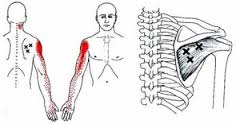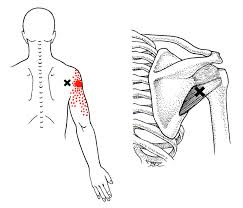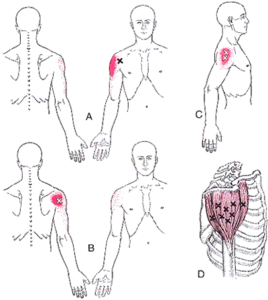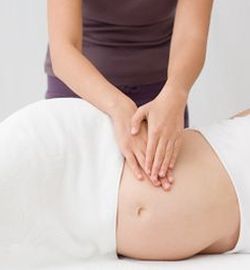Down
load your Unresolved-Shoulder-Pain-Report and schedule your FREE shoulder pain assessment!
 The shoulder joint is a ball and socket joint with the most flexibility of any joint in our body. This allows for incredible range of motion in flexion, extension, abduction, adduction, internal and external rotation. On the downside, such flexibility leaves the joint itself unstable. It is the work of the rotator cuff muscles, along with tendons and ligaments to provide the stability it needs. There are 3 bones that make up the shoulder joint: the humerus, the scapula and the clavicle. The articulations between these bones make up 4 different joints in the shoulder. The glenoid labrum is fibrocartilage that is attached to the inside of the glenoid fossa. It provides additional depth and support that contributes to the overall stability. It is an attachment for ligaments and is continuous with the long head of the biceps brachii. If the labrum gets torn, symptoms include:
The shoulder joint is a ball and socket joint with the most flexibility of any joint in our body. This allows for incredible range of motion in flexion, extension, abduction, adduction, internal and external rotation. On the downside, such flexibility leaves the joint itself unstable. It is the work of the rotator cuff muscles, along with tendons and ligaments to provide the stability it needs. There are 3 bones that make up the shoulder joint: the humerus, the scapula and the clavicle. The articulations between these bones make up 4 different joints in the shoulder. The glenoid labrum is fibrocartilage that is attached to the inside of the glenoid fossa. It provides additional depth and support that contributes to the overall stability. It is an attachment for ligaments and is continuous with the long head of the biceps brachii. If the labrum gets torn, symptoms include:
- A deep aching pain that is difficult to pinpoint its location
- Weakness in the shoulder joint
- Popping or clicking in the shoulder
- Pain reaching overhead
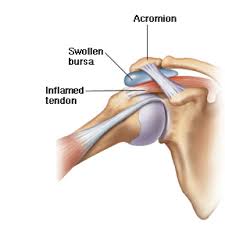 There are several bursae sacs in the shoulder joint. This is necessary to prevent friction with such great movement. The most commonly irritated bursa is the subacromial bursa, due to its location under the acromion process of the scapula.
There are several bursae sacs in the shoulder joint. This is necessary to prevent friction with such great movement. The most commonly irritated bursa is the subacromial bursa, due to its location under the acromion process of the scapula.
Bursitis occurs when a bursa becomes inflamed due to various reasons (shoulder impingement caused by muscle imbalances, autoimmune disorders, infections). Subacromial bursitis often accompanies Rotator Cuff Tendonitis. The symptoms of shoulder bursitis are localized swelling and tenderness in the area of the bursa, and pain when moving the arm out to the side.
The main ligaments that support the shoulder are: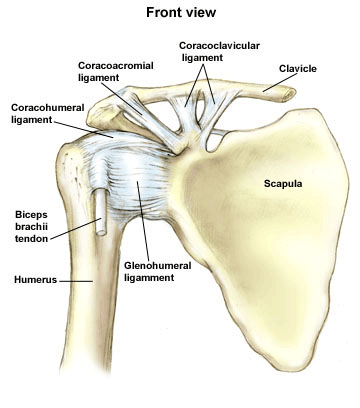
- Coracoclavicular ligaments
- Coracoacromial ligament
- Coracohumeral ligament
- Glenohumeral ligament
These ligaments are very important for the stability of the shoulder and also a source of pain when they are damaged. There are 3 grades of sprains, going from mild to severe damage. Symptoms will vary depending on how bad the injury is. Immediately after the injury there will be swelling around the top of the shoulder and the damaged ligament will be painful to touch. If the injury is severe, there will be a lack of stability in the shoulder joint.
There are 4 muscles that make up the rotator cuff. They are the suprapinatus, infraspinatus, teres minor and subscapularis muscles. The supraspinatus muscle is most frequently injured, followed by the infraspinatus muscle. Active trigger points in any of these muscles can also cause a great deal of pain. Each muscle presents with its own set of symptoms when injured or carrying active trigger points.
Symptoms include:
- Pain on the shoulder around the AC joint
- Pain when lifting the arm out to the side
- Pain holding the arm out to the side
- Pain with overhead movements
- Pain with daily activities, such as brushing your hair or teeth
- There may be pain referral to the elbow
Symptoms include:
- Pain on the front and/or side of the shoulder
- Pain reaching behind you
- Pain reaching into your back pocket
- Pain when holding your arm in front of you, such as a computer mouse or driving
- Pain sleeping on your side
- Pain with pushing, such as pushing up out of a chair
Symptoms include:
- Pain on the back of the shoulder
- Pain that may seem deep in the shoulder and be mistaken for Bursitis
- Pain when putting on a shirt or jacket
- Pain reaching backwards
Subscapularis
- Pain reaching backward when the arm is out to the side, like throwing a ball
- Pain that can cause shoulder restriction that mimics a frozen shoulder
- Severe pain on the back of the shoulder
- Pain reaching across the body
- Pain may radiate down the back of the arm to the wrist
Other muscles that are involved in shoulder pain include the teres major and deltoid muscles.
While this is not a “rotator cuff” muscle, it may be involved in your shoulder pain. Symptoms include:
- Pain on the back of the shoulder
- Pain when bringing the arm out to the side or in front of you
The deltoid muscle has 3 different heads: anterior, middle and posterior. All 3 portions of the deltoid contribute to bringing your arm out to the side. However, the anterior deltoid also functions to bring your arm towards your body and to rotate your arm inward (internal rotation). The posterior deltoid helps to extend your arm backwards and to rotate your arm outward (external rotation).
Pain associated with the deltoid muscle depends upon which portion of the muscle is affected. Dysfunction with the muscle sometimes develops secondarily Rotator Cuff Syndrome or because of axillary nerve irritation. It can also be caused by overload of the muscle, as with weightlifting or carrying heavy objects.
- Pain on the front, side or back of the shoulder
- Pain occurs with movement of the shoulder
- Pain when loading the shoulder, as in carrying a heavy object
- Weakness in the shoulder
- Tingling or numbness over the shoulder (this means the axillary nerve is involved)
A thorough assessment of your shoulder should be performed prior to treatment. Schedule your free shoulder pain assessment today!





